初中英语语法教学设计
- 格式:doc
- 大小:38.00 KB
- 文档页数:2
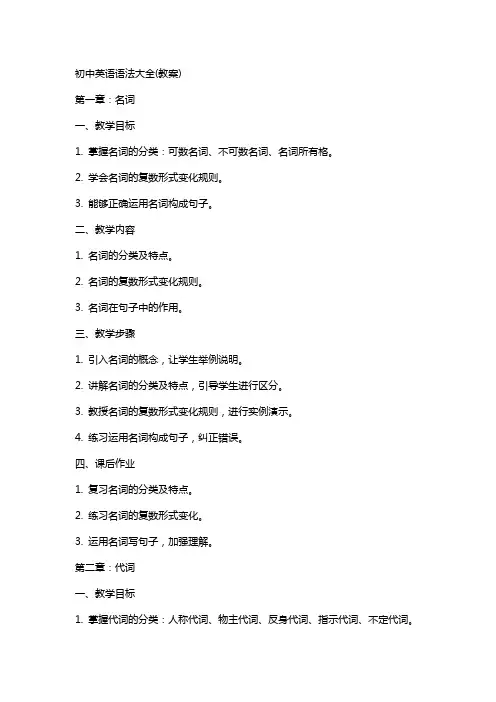
初中英语语法大全(教案)第一章:名词一、教学目标1. 掌握名词的分类:可数名词、不可数名词、名词所有格。
2. 学会名词的复数形式变化规则。
3. 能够正确运用名词构成句子。
二、教学内容1. 名词的分类及特点。
2. 名词的复数形式变化规则。
3. 名词在句子中的作用。
三、教学步骤1. 引入名词的概念,让学生举例说明。
2. 讲解名词的分类及特点,引导学生进行区分。
3. 教授名词的复数形式变化规则,进行实例演示。
4. 练习运用名词构成句子,纠正错误。
四、课后作业1. 复习名词的分类及特点。
2. 练习名词的复数形式变化。
3. 运用名词写句子,加强理解。
第二章:代词一、教学目标1. 掌握代词的分类:人称代词、物主代词、反身代词、指示代词、不定代词。
2. 学会代词的用法及注意事项。
3. 能够正确运用代词构成句子。
二、教学内容1. 代词的分类及特点。
2. 代词的用法及注意事项。
3. 代词在句子中的作用。
三、教学步骤1. 引入代词的概念,让学生举例说明。
2. 讲解代词的分类及特点,引导学生进行区分。
3. 教授代词的用法及注意事项,进行实例演示。
4. 练习运用代词构成句子,纠正错误。
四、课后作业1. 复习代词的分类及特点。
2. 练习代词的用法及注意事项。
3. 运用代词写句子,加强理解。
第三章:形容词和副词一、教学目标1. 掌握形容词和副词的分类及特点。
2. 学会形容词和副词的比较级和最高级形式变化。
3. 能够正确运用形容词和副词构成句子。
二、教学内容1. 形容词和副词的分类及特点。
2. 形容词和副词的比较级和最高级形式变化规则。
3. 形容词和副词在句子中的作用。
三、教学步骤1. 引入形容词和副词的概念,让学生举例说明。
2. 讲解形容词和副词的分类及特点,引导学生进行区分。
3. 教授形容词和副词的比较级和最高级形式变化规则,进行实例演示。
4. 练习运用形容词和副词构成句子,纠正错误。
四、课后作业1. 复习形容词和副词的分类及特点。
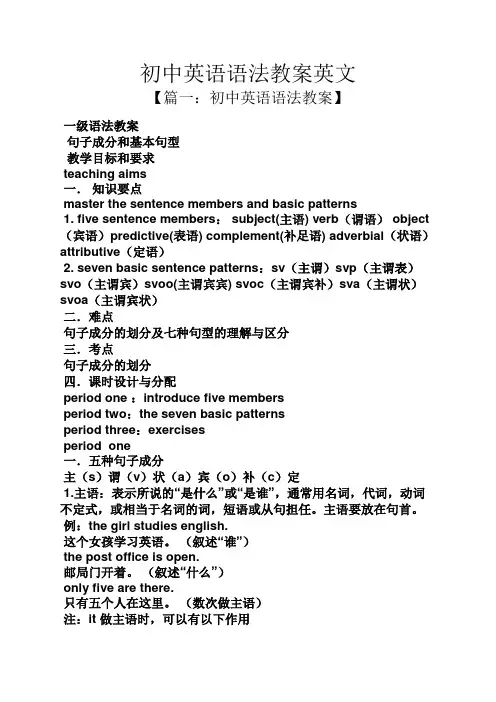
初中英语语法教案英文【篇一:初中英语语法教案】一级语法教案句子成分和基本句型教学目标和要求teaching aims一.知识要点master the sentence members and basic patterns1. five sentence members: subject(主语) verb(谓语) object (宾语)predictive(表语) complement(补足语) adverbial(状语)attributive(定语)2. seven basic sentence patterns:sv(主谓)svp(主谓表)svo(主谓宾)svoo(主谓宾宾) svoc(主谓宾补)sva(主谓状)svoa(主谓宾状)二.难点句子成分的划分及七种句型的理解与区分三.考点句子成分的划分四.课时设计与分配period one :introduce five membersperiod two:the seven basic patternsperiod three:exercisesperiod one一.五种句子成分主(s)谓(v)状(a)宾(o)补(c)定1.主语:表示所说的“是什么”或“是谁”,通常用名词,代词,动词不定式,或相当于名词的词,短语或从句担任。
主语要放在句首。
例:the girl studies english.这个女孩学习英语。
(叙述“谁”)the post office is open.邮局门开着。
(叙述“什么”)only five are there.只有五个人在这里。
(数次做主语)注:it 做主语时,可以有以下作用1).表示时间、天气、季节、距离和自然现象。
it’s windy today.今天刮风了。
2).表示刚刚提到的事情。
what’s this?it’s a fox.这是什么?它是一只狐狸。
3).起指示代词的作用,表示人或事物。
who is itoutside?it’s hey.外面是谁?是亨利。
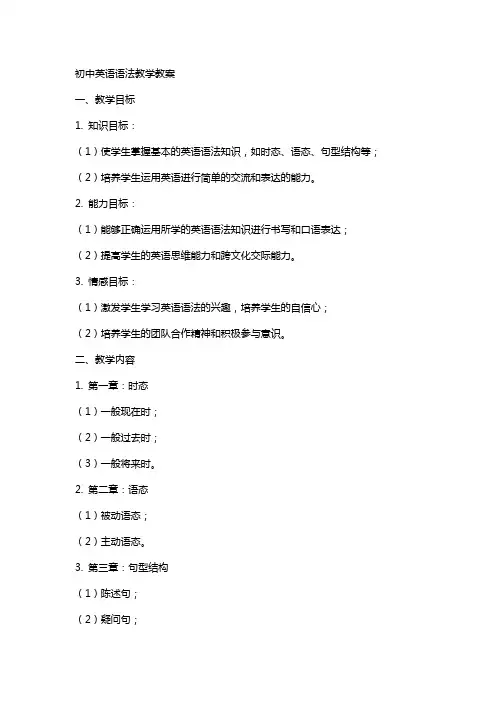
初中英语语法教学教案一、教学目标1. 知识目标:(1)使学生掌握基本的英语语法知识,如时态、语态、句型结构等;(2)培养学生运用英语进行简单的交流和表达的能力。
2. 能力目标:(1)能够正确运用所学的英语语法知识进行书写和口语表达;(2)提高学生的英语思维能力和跨文化交际能力。
3. 情感目标:(1)激发学生学习英语语法的兴趣,培养学生的自信心;(2)培养学生的团队合作精神和积极参与意识。
二、教学内容1. 第一章:时态(1)一般现在时;(2)一般过去时;(3)一般将来时。
2. 第二章:语态(1)被动语态;(2)主动语态。
3. 第三章:句型结构(1)陈述句;(2)疑问句;(3)祈使句;(4)感叹句。
4. 第四章:情态动词(1)can;(2)may;(3)must;(4)shall;(5)will。
5. 第五章:代词(1)人称代词;(2)物主代词;(3)指示代词;(4)疑问代词。
三、教学方法1. 情境教学法:通过设定各种实际情境,让学生在实践中学习和运用语法知识。
2. 任务型教学法:通过完成各种任务,培养学生运用语法知识进行交流的能力。
3. 互动式教学法:引导学生积极参与课堂活动,进行师生互动、生生互动。
4. 直观教学法:利用图片、实物、多媒体等直观手段,帮助学生理解和记忆语法知识。
四、教学评价1. 课堂参与度:观察学生在课堂活动中的参与程度,是否积极发言、主动提问等。
2. 口语表达:评估学生在口语交流中运用语法知识的情况,如句子结构、时态、语态等。
3. 作业完成情况:检查学生作业中语法知识的运用情况,如句子结构、时态、语态等。
4. 测试成绩:定期进行语法测试,评估学生的语法知识掌握程度。
五、教学资源1. 教材:选用适合初中学生的英语语法教材,如《新概念英语》等。
2. 多媒体课件:制作生动有趣的课件,辅助教学。
3. 图片、实物:利用图片、实物等直观手段,帮助学生理解和记忆语法知识。
4. 练习题库:准备丰富的练习题,巩固所学语法知识。
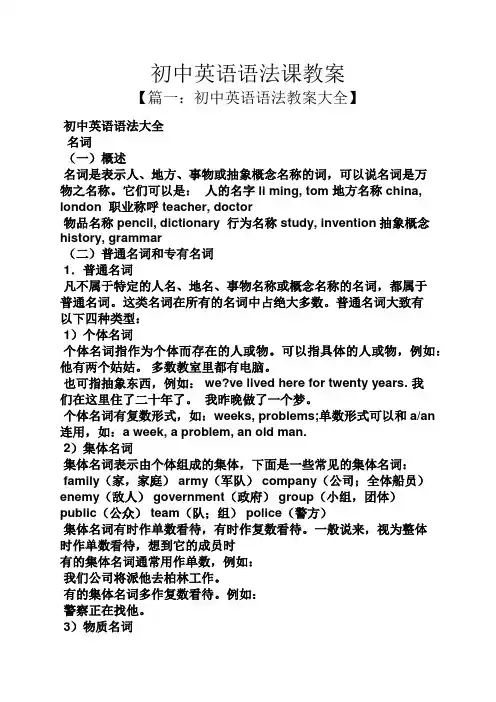
初中英语语法课教案【篇一:初中英语语法教案大全】初中英语语法大全名词(一)概述名词是表示人、地方、事物或抽象概念名称的词,可以说名词是万物之名称。
它们可以是:人的名字 li ming, tom 地方名称 china, london 职业称呼 teacher, doctor物品名称 pencil, dictionary 行为名称 study, invention抽象概念history, grammar(二)普通名词和专有名词1.普通名词凡不属于特定的人名、地名、事物名称或概念名称的名词,都属于普通名词。
这类名词在所有的名词中占绝大多数。
普通名词大致有以下四种类型:1)个体名词个体名词指作为个体而存在的人或物。
可以指具体的人或物,例如:他有两个姑姑。
多数教室里都有电脑。
也可指抽象东西,例如: we?ve lived here for twenty years. 我们在这里住了二十年了。
我昨晚做了一个梦。
个体名词有复数形式,如:weeks, problems;单数形式可以和a/an 连用,如:a week, a problem, an old man.2)集体名词集体名词表示由个体组成的集体,下面是一些常见的集体名词:family(家,家庭) army(军队) company(公司;全体船员)enemy(敌人) government(政府) group(小组,团体)public(公众) team(队;组) police(警方)集体名词有时作单数看待,有时作复数看待。
一般说来,视为整体时作单数看待,想到它的成员时有的集体名词通常用作单数,例如:我们公司将派他去柏林工作。
有的集体名词多作复数看待。
例如:警察正在找他。
3)物质名词物质名词指无法分为个体的东西,我们学过的常见的物质名词有:beer, cloth, coal, coffee, coke, cotton, ice, ink, jam, juice, meat, medicine, metal, milk, oil paper, rain, salad, salt, sand, snow, soup, steel, sugar, tea, water, wine, wood, wool等。
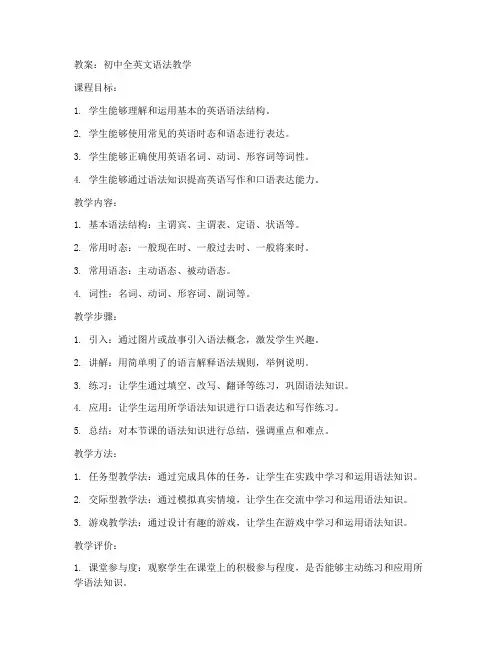
教案:初中全英文语法教学课程目标:1. 学生能够理解和运用基本的英语语法结构。
2. 学生能够使用常见的英语时态和语态进行表达。
3. 学生能够正确使用英语名词、动词、形容词等词性。
4. 学生能够通过语法知识提高英语写作和口语表达能力。
教学内容:1. 基本语法结构:主谓宾、主谓表、定语、状语等。
2. 常用时态:一般现在时、一般过去时、一般将来时。
3. 常用语态:主动语态、被动语态。
4. 词性:名词、动词、形容词、副词等。
教学步骤:1. 引入:通过图片或故事引入语法概念,激发学生兴趣。
2. 讲解:用简单明了的语言解释语法规则,举例说明。
3. 练习:让学生通过填空、改写、翻译等练习,巩固语法知识。
4. 应用:让学生运用所学语法知识进行口语表达和写作练习。
5. 总结:对本节课的语法知识进行总结,强调重点和难点。
教学方法:1. 任务型教学法:通过完成具体的任务,让学生在实践中学习和运用语法知识。
2. 交际型教学法:通过模拟真实情境,让学生在交流中学习和运用语法知识。
3. 游戏教学法:通过设计有趣的游戏,让学生在游戏中学习和运用语法知识。
教学评价:1. 课堂参与度:观察学生在课堂上的积极参与程度,是否能够主动练习和应用所学语法知识。
2. 练习完成情况:检查学生完成练习的情况,是否能够正确运用语法知识。
3. 口语表达和写作能力:通过口语表达和写作练习,评估学生对语法知识的掌握程度。
教学资源:1. 教材:选择适合初中生水平的英语教材,如《新概念英语》等。
2. 图片:准备与教学内容相关的图片,帮助学生更好地理解和记忆语法规则。
3. 故事:准备与教学内容相关的故事,激发学生兴趣并引导学生进行思考。
教学计划:1. 第一课时:介绍主谓宾、主谓表、定语、状语等基本语法结构。
2. 第二课时:学习一般现在时、一般过去时、一般将来时的运用。
3. 第三课时:学习主动语态和被动语态的运用。
4. 第四课时:学习名词、动词、形容词、副词等词性的运用。
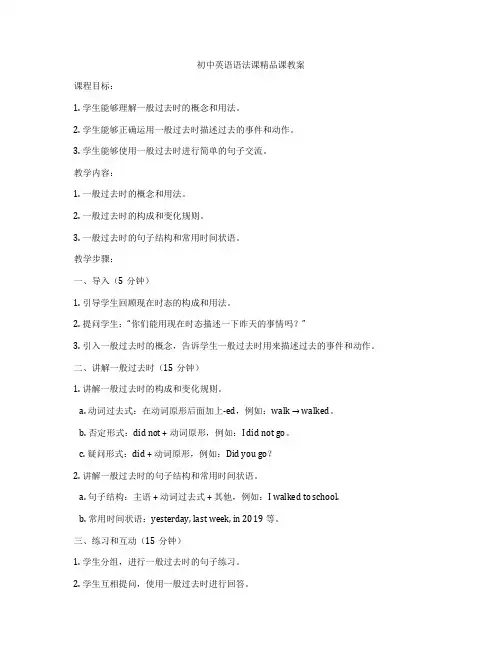
初中英语语法课精品课教案课程目标:1. 学生能够理解一般过去时的概念和用法。
2. 学生能够正确运用一般过去时描述过去的事件和动作。
3. 学生能够使用一般过去时进行简单的句子交流。
教学内容:1. 一般过去时的概念和用法。
2. 一般过去时的构成和变化规则。
3. 一般过去时的句子结构和常用时间状语。
教学步骤:一、导入(5分钟)1. 引导学生回顾现在时态的构成和用法。
2. 提问学生:“你们能用现在时态描述一下昨天的事情吗?”3. 引入一般过去时的概念,告诉学生一般过去时用来描述过去的事件和动作。
二、讲解一般过去时(15分钟)1. 讲解一般过去时的构成和变化规则。
a. 动词过去式:在动词原形后面加上-ed,例如:walk → walked。
b. 否定形式:did not + 动词原形,例如:I did not go。
c. 疑问形式:did + 动词原形,例如:Did you go?2. 讲解一般过去时的句子结构和常用时间状语。
a. 句子结构:主语 + 动词过去式 + 其他,例如:I walked to school.b. 常用时间状语:yesterday, last week, in 2019等。
三、练习和互动(15分钟)1. 学生分组,进行一般过去时的句子练习。
2. 学生互相提问,使用一般过去时进行回答。
3. 教师选取一些学生的句子,进行展示和点评。
四、巩固和拓展(10分钟)1. 学生完成一篇关于一般过去时的短文填空练习。
2. 学生尝试用一般过去时编写一个小故事。
五、总结和作业(5分钟)1. 教师引导学生总结一般过去时的概念和用法。
2. 布置作业:用一般过去时写一篇日记,描述昨天的事情。
教学评价:1. 观察学生在课堂上的参与度和练习情况。
2. 评估学生完成练习和作业的质量。
3. 学生对一般过去时的掌握程度。
教学资源:1. PPT展示一般过去时的构成和变化规则。
2. 练习题和短文填空练习。
教学建议:1. 在课堂上鼓励学生多开口练习,增强语言表达能力。
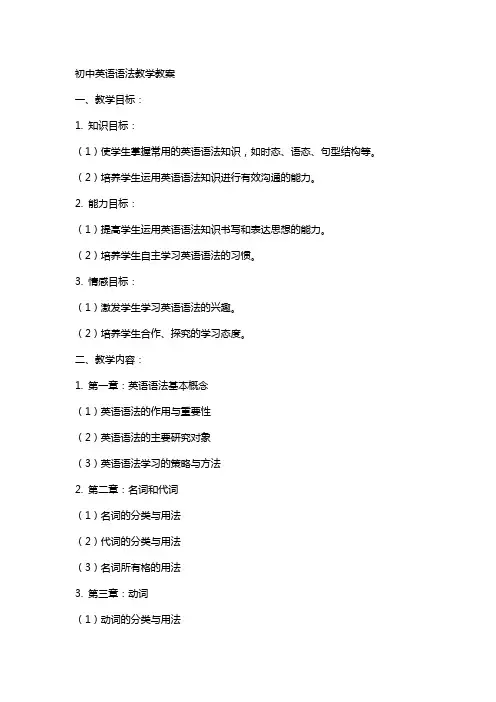
初中英语语法教学教案一、教学目标:1. 知识目标:(1)使学生掌握常用的英语语法知识,如时态、语态、句型结构等。
(2)培养学生运用英语语法知识进行有效沟通的能力。
2. 能力目标:(1)提高学生运用英语语法知识书写和表达思想的能力。
(2)培养学生自主学习英语语法的习惯。
3. 情感目标:(1)激发学生学习英语语法的兴趣。
(2)培养学生合作、探究的学习态度。
二、教学内容:1. 第一章:英语语法基本概念(1)英语语法的作用与重要性(2)英语语法的主要研究对象(3)英语语法学习的策略与方法2. 第二章:名词和代词(1)名词的分类与用法(2)代词的分类与用法(3)名词所有格的用法3. 第三章:动词(1)动词的分类与用法(2)动词时态的用法(3)动词语态的用法4. 第四章:形容词和副词(1)形容词的分类与用法(2)副词的分类与用法(3)形容词和副词的比较级和最高级5. 第五章:句子结构与句型(1)简单句的结构(2)并列句的用法(3)复合句的用法三、教学方法:1. 采用任务型教学法,让学生在实践中学习和运用语法知识。
2. 运用多媒体教学手段,直观展示语法知识,提高学生的学习兴趣。
3. 组织小组讨论和合作活动,培养学生的团队协作能力。
4. 注重个体差异,因材施教,给予每个学生充分的关注和指导。
四、教学评价:1. 过程性评价:关注学生在学习过程中的表现,如态度、参与度、合作精神等。
2. 形成性评价:通过课堂练习、作业、测试等,检查学生语法知识的掌握情况。
3. 终结性评价:在学习结束后,进行语法知识的综合测试,评估学习成果。
五、教学资源:1. 教材:人教版《新目标》初中英语教材。
2. 辅助材料:语法讲解PPT、实例句子、练习题等。
3. 教学设备:投影仪、计算机、音响等。
4. 网络资源:英语语法学习网站、在线测试等。
六、第六章:情态动词1. 情态动词的定义与分类2. 情态动词的基本用法3. 情态动词辨析及用法举例4. 情态动词在特定语境中的运用七、第七章:介词和连词1. 介词的分类与用法2. 常见连词的分类与用法3. 介词和连词在句子中的作用4. 介词和连词的搭配及辨析八、第八章:疑问句和否定句1. 疑问句的种类与构造2. 疑问句的用法和语调3. 否定句的构成和用法4. 疑问句和否定句在实际交际中的应用九、第九章:听力理解和口语表达1. 听力理解技巧训练2. 提高听力理解的策略3. 口语表达的基本原则4. 日常英语口语情景对话练习十、第十章:语法综合练习与拓展1. 语法知识综合测试2. 错题分析和解答3. 语法知识拓展与延伸4. 学习方法和建议教学计划:每周安排两节语法课,每节课时长45分钟。
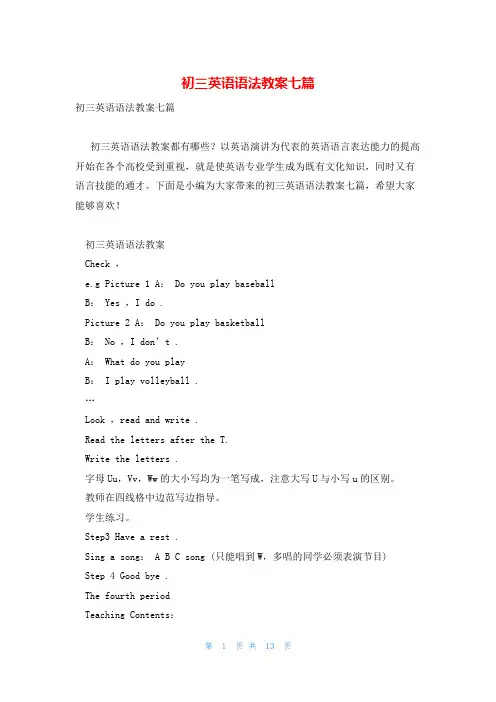
初三英语语法教案七篇初三英语语法教案七篇初三英语语法教案都有哪些?以英语演讲为代表的英语语言表达能力的提高开始在各个高校受到重视,就是使英语专业学生成为既有文化知识,同时又有语言技能的通才。
下面是小编为大家带来的初三英语语法教案七篇,希望大家能够喜欢!初三英语语法教案Check ,e.g Picture 1 A: Do you play baseballB: Yes ,I do .Picture 2 A: Do you play basketballB: No ,I don’t .A: What do you playB: I play volleyball .…Look ,read and write .Read the letters after the T.Write the letters .字母Uu,Vv,Ww的大小写均为一笔写成,注意大写U与小写u的区别。
教师在四线格中边范写边指导。
学生练习。
Step3 Have a rest .Sing a song: A B C song (只能唱到W,多唱的同学必须表演节目)Step 4 Good bye .The fourth periodTeaching Contents:D Fun house :Workbook .Teaching Aims:继续练习本单元所学的日常交际用语和单词,使学生能熟练掌握,灵活运用。
指导学生完成书后的练习和练习册中的题目。
Teaching Steps:Step1 Warm upGreetings.Sing a song: We study and play .Listen and do :Let’s fly .Let’s jump.Let’s read andwrite .Let’s have a drink .Step 2 Presentation .Draw and guess :a .教师在黑板上画出乐器类和球类物品的简笔画,学生猜出相应的单词。
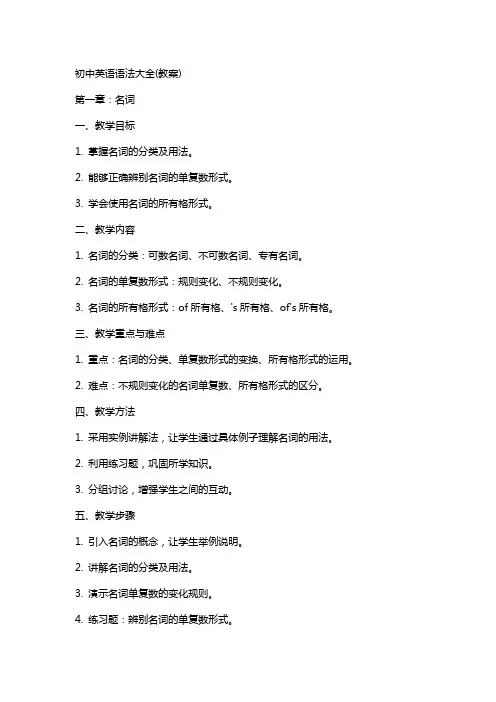
初中英语语法大全(教案)第一章:名词一、教学目标1. 掌握名词的分类及用法。
2. 能够正确辨别名词的单复数形式。
3. 学会使用名词的所有格形式。
二、教学内容1. 名词的分类:可数名词、不可数名词、专有名词。
2. 名词的单复数形式:规则变化、不规则变化。
3. 名词的所有格形式:of所有格、's所有格、of's所有格。
三、教学重点与难点1. 重点:名词的分类、单复数形式的变换、所有格形式的运用。
2. 难点:不规则变化的名词单复数、所有格形式的区分。
四、教学方法1. 采用实例讲解法,让学生通过具体例子理解名词的用法。
2. 利用练习题,巩固所学知识。
3. 分组讨论,增强学生之间的互动。
五、教学步骤1. 引入名词的概念,让学生举例说明。
2. 讲解名词的分类及用法。
3. 演示名词单复数的变化规则。
4. 练习题:辨别名词的单复数形式。
5. 讲解名词的所有格形式及用法。
6. 练习题:运用名词的所有格形式。
7. 总结本节课的重点内容。
第二章:冠词一、教学目标1. 掌握不定冠词a/an的用法。
2. 学会定冠词the的用法。
3. 能够正确运用零冠词。
二、教学内容1. 不定冠词a/an的用法:表示泛指、用于可数名词单数。
2. 定冠词the的用法:表示特指、表示独一无二的事物、用于固定搭配。
3. 零冠词的用法:表示泛指、用于不可数名词、某些抽象概念。
三、教学重点与难点1. 重点:不定冠词a/an的用法、定冠词the的用法、零冠词的运用。
2. 难点:不定冠词与定冠词的区分、零冠词的运用。
四、教学方法1. 采用情景教学法,让学生在实际语境中学习冠词的用法。
2. 利用练习题,巩固所学知识。
3. 小组讨论,增强学生之间的互动。
五、教学步骤1. 引入冠词的概念,让学生举例说明。
2. 讲解不定冠词a/an的用法。
3. 练习题:辨别不定冠词的使用场合。
4. 讲解定冠词the的用法。
5. 练习题:辨别定冠词的使用场合。
6. 讲解零冠词的用法。
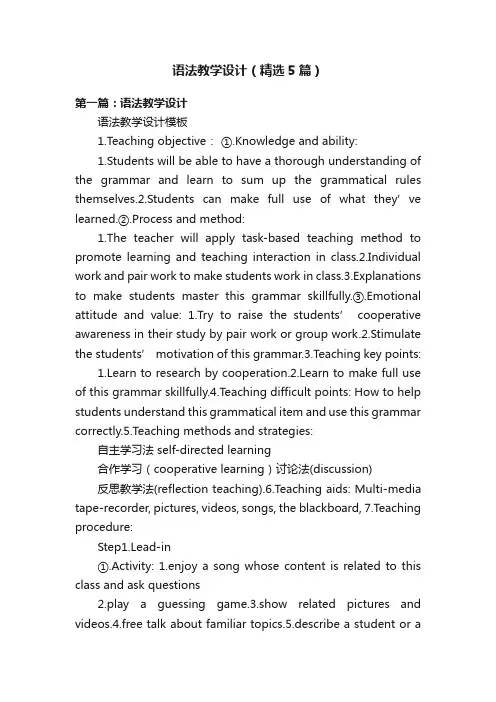
语法教学设计(精选5篇)第一篇:语法教学设计语法教学设计模板1.Teaching objective:①.Knowledge and ability:1.Students will be able to have a thorough understanding of the grammar and learn to sum up the grammatical rules themselves.2.Students can make full use of what they’ve learned.②.Process and method:1.The teacher will apply task-based teaching method to promote learning and teaching interaction in class.2.Individual work and pair work to make students work in class.3.Explanations to make students master this grammar skillfully.③.Emotional attitude and value: 1.Try to raise the students’ cooperative awareness in their study by pair work or group work.2.Stimulate the students’ motivation of this gramma r.3.Teaching key points:1.Learn to research by cooperation.2.Learn to make full use of this grammar skillfully.4.Teaching difficult points: How to help students understand this grammatical item and use this grammar correctly.5.Teaching methods and strategies:自主学习法 self-directed learning合作学习(cooperative learning)讨论法(discussion)反思教学法(reflection teaching).6.Teaching aids: Multi-media tape-recorder, pictures, videos, songs, the blackboard, 7.Teaching procedure:Step1.Lead-in①.Activity: 1.enjoy a song whose content is related to this class and ask questions2.play a guessing game.3.show related pictures and videos.4.free talk about familiar topics.5.describe a student or ateacher in our school.6.show students’ works related to this class.7.make a dialogue about the knowledge of this class.②.Purpose: 1.to bring out the topic of this class.2.stimulate the learning interest and motivation.3.motivate students to be interested in this class.4.to attract the students’ attention quickly, and in coordination with the grammar of this class.Step 2.Review and Presentation.1.Summarize the grammatical rules through situations Activity: ①.Check the answers of exercises in the guiding paper quickly.②.Give students’ different situations or different tasks using pictures of t he latest events.③.Lead students to summarize the grammatical rules.(pair work, individual work, and cooperation)Purpose: advocate students’ logical thinking ability and summary ability.2.Group discussion: Activity: group work, pair work , team work , the teacher gives the students instructions if necessary.Purpose: ①.improve students’ ability to organize and summarize.②.arouse students’ interest in this grammar and encourage students to use the cooperative learning method.Step 3.Explorative Activity: Activ ity: ①.make sentences with this grammar ②.do some sentence translations ③.write a short composition ④.do an oral task ⑤.make a dialogue Purpose: ①.Improve students’ comprehensive ability and expressing ability.②.Apply what they’ve learned to practice to co nsolidate this grammar.③.Help students acquire a good command of this grammar.Step 4.Consolidation:1.Activity: quiz, retell, analysis of vocabulary, oral composition, translationPlay a game with different titles“ challenge NMET”“passage correcting”“look and say”“ sentence changing”“ filling in the blanks”2.Purpose: ①.make students closely connected with NMET,②.be familiar with the exercises of NMET, ③.practice their writing skills.Step 5.SummaryTo evaluate the students’ ability and have a sense of achievements Step 6.Evaluation and Reflection Purpose: Through evaluation, students can assess their learning result and how to master this grammar, and whether they’ve learnt to use the “FAT”.Step 7.Assignment/ homeworkActivity: a composition titled “_________”.In this passage, more _________ are required.Purpose: apply what they have learned to practice and improve students’ writing skills.术语:1.新课程标准New Curriculum Criteria2.In this way, not only will students’ learning motivation be greatly stimulated, but also their communication skills will be effectively improved.第二篇:语法教学设计人教版:高中英语必修二 Unit1In search of the Amber Room语法课教学设计1.Analysis of teaching materials The non-restrictive attributive clause is the new grammar item of this unit.We will review the Attributive Clause and try to master the relative pronouns better, and learn more about the differences between the restrictive attributive clause and non-restrictive attributive clause.2.Analysis of students The students have learned structure, usage, characters of attributive clauses before.So they can be easy to accept the non-restrictive attributive clause.3.Teachingobjectives Knowledge objectiveAt the end of the class, most of the students can be able to 1)Master the structure of non-restrictive attributive clause.2)Can join two sentences into a sentence using attributive clauses.3)Can divide a non-restrictive attributive clause into two simple sentences.4.Teaching important points The structure of non-restrictive attributive clause 5.Teaching difficult points Distinguish the differences between the restrictive attributive clause and non-restrictive attributive clause.6.Teaching methods PPP Model, TBLT T eaching procedure Step1: Warming up 1.Give students some attributive clauses sentences to recall what they have learnt before, and then let some of the students to describe the characters and what they have known about the attributive clauses sentence.2.Task: at the end of the class you should use the non-restrictive attributive clauses sentences to describe one place which you like best.Step2: Presentation1.Underline all the attributive clauses in the text.1)This gift was the Amber Room, which was given this name because several tons of ambers were used to make it.2)The amber which was selected had a beautiful yellow-brown colour like honey.3)Frederick William I, to whom the amber room belonged, decided not to keep it.………pare of all the sentences that you found and notice the use of commas, what are the differences between them? Try to define non-restrictive clauses in your own words.Sa: ………Sb: ……… 3.Teacher introduces the non-restrictive attributive clauses sentences and summarizes the differences of them the two.Step3: Practice 1.Pick up the non-restrictive attributive sentences.4.I know nothing that happened last night.5.He was generous with time, for which I was grateful.6.Do you know thepeople who live over the road? 7.The accident, which took place in Kingston, a town southwest of London, happened because of the fog.8.There are 20 students in this class who are from the north of China.9.There are 20 students in this class, who are from the north of China.2.Join the pairs of sentences using attributive clauses(restrictive or non-restrictive).P4.3 1)Here are the farmers.They discovered the underground city last month.2)Hangzhou is a famous city in China.Many people come to buy tea in that city.…………3.In groups of four, look at the sentences plete them by adding the restrictive or non-restrictive attributive clauses.EXAMPLE: The king had many beautiful art objects.The king whose palace was decorated in gold and jewels had many beautiful art objects.1)The mother _________________________________was very proud.2)The man ____________________________________was a farmer.3)The wooden box _____________________was made a long time ago.Step4: Production1.Try to define non-restrictive clauses in your own words.2.Try to divide the non-restrictive clauses into two simple sentences.1)He sold his bike, which surprised me._______________________________________________________ 2)He lost his temper, at which point I decided to leave here._______________________________________________________3)Here`s a letter from the Browns, who want to come to Paris.________________________________________________________ 3.Try to use the non-restrictive attributive clauses sentences to describe one place which you like best.(free talk)Step5: Home work Use the non-restrictive attributive clauses sentences to write a short passage about one thing you like best.第三篇:现在进行时语法教学设计篇一:现在进行时复习教学设计七年级英语第二单元语法复习教学设计1 2 篇二:现在进行时教学设计《现在进行时》教学设计肥城市桃园镇初级中学李纬纬 ? 篇三:现在进行时教学案例现在进行时教学案例【教案背景】现在进行时外研社七年级下册modules1-2的语法项目,该语法既是本册书的重点与法之一,也是难点之一。
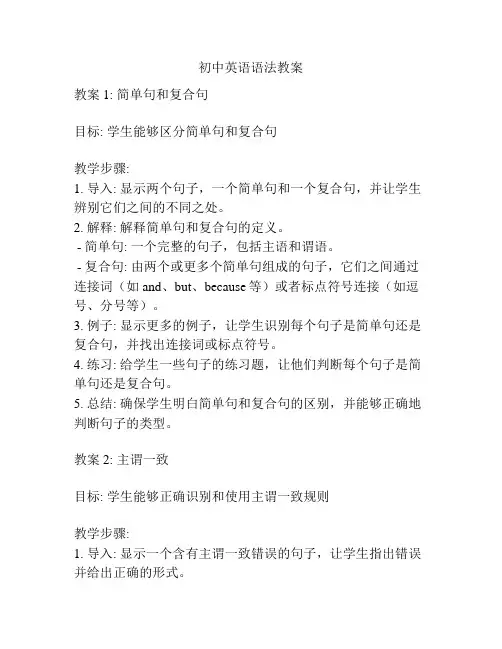
初中英语语法教案教案 1: 简单句和复合句目标: 学生能够区分简单句和复合句教学步骤:1. 导入: 显示两个句子,一个简单句和一个复合句,并让学生辨别它们之间的不同之处。
2. 解释: 解释简单句和复合句的定义。
- 简单句: 一个完整的句子,包括主语和谓语。
- 复合句: 由两个或更多个简单句组成的句子,它们之间通过连接词(如and、but、because等)或者标点符号连接(如逗号、分号等)。
3. 例子: 显示更多的例子,让学生识别每个句子是简单句还是复合句,并找出连接词或标点符号。
4. 练习: 给学生一些句子的练习题,让他们判断每个句子是简单句还是复合句。
5. 总结: 确保学生明白简单句和复合句的区别,并能够正确地判断句子的类型。
教案 2: 主谓一致目标: 学生能够正确识别和使用主谓一致规则教学步骤:1. 导入: 显示一个含有主谓一致错误的句子,让学生指出错误并给出正确的形式。
2. 解释: 解释主谓一致的规则。
- 如果主语是单数,谓语动词必须用单数形式。
- 如果主语是复数,谓语动词必须用复数形式。
3. 例子: 显示更多的例子,让学生判断主谓是否一致,并给出正确形式。
4. 练习: 给学生一些句子的练习题,让他们判断主谓是否一致,并给出正确形式。
5. 总结: 确保学生明白主谓一致的规则,并能够正确地使用它们。
教案 3: 时态的使用目标: 学生能够正确使用一般现在时、一般过去时和一般将来时教学步骤:1. 导入: 显示一个句子,含有错误的时态形式,并让学生指出错误和给出正确的形式。
2. 解释: 解释一般现在时、一般过去时和一般将来时的使用规则。
- 一般现在时: 表示目前的状态、经常性的动作或客观事实。
- 一般过去时: 表示过去发生的动作或状态。
- 一般将来时: 表示将来要发生的动作或状态。
3. 例子: 显示更多的例子,让学生识别句子中的时态,并给出正确的形式。
4. 练习: 给学生一些句子的练习题,让他们选择正确的时态形式。
初一英语语法教案设计初一英语语法教案1一、教材分析:1、教学内容:本单元是——(下) Unit —。
要紧围绕""这一主题开放各种教学活动,并以这一主题引出_____等语言功能。
本单元旨在制造一个轻松,快乐的学习,沟通环境,通过听,讲,读,写来培育同学综合运用这些学问的力气。
并让同学能在"做中学"(learning by doing),通过有限的课堂实践活动,拓展以往的经受,能精确地用英语来表达。
2、教材的地位和作用:——班级——单元叙述的是——的用法,这是学校特别重要的时态之一。
同学们能够用现如今——来表达自个儿的经受,来体会不人的感受是特殊重要的。
那个单元确定要体会现如今——的真正含义和用法。
要幸免混淆几个重点词组的使用。
我们更要使同学不仅理解枯燥的语法,还要让同学们会用新学的语法学问来表达思想。
3、教材的处理:依照《英语课程标准》(试验稿)关于总目标的具体描述,结合本单元这部分的教学内容及基于对教材的分析,我对本单元的内容进行如下处理,目的是突出重点,使课堂节奏紧凑,衔贯。
本单元分为四课时,第一课时是Section A,其次课时是Section B,第三课时是Self Check,第四课时是——,后来一部分是做练习,以同学的自测为主,接着予以校对。
二、学情分析:我们教学的对象是初二同学(好,中,差等生都有),他们学习英语既感到惊奇又担忧,希望能得到他人的确信。
因此我在教学活动中尽可能让他们参与到活动中来,有更多的机遇来讲英语,削减他们的恐惊感,通过同学间的合作学习,落低他们的学习难度,使他们体验到成功的喜悦。
同时在阅读和书面表达中加以落实,提高他们综合运用语言的力气,使各层次的同学都有所收获。
三、教学目标:依照以上我对本单元教材内容的分析和新课标的指导,我确定以下几个为本单元的教学目标:语言学问,语言技能,学习策略,情感态度和文化意识五个方面。
1、语言学问:本单元要求同学把握以下词汇——语言功能:学习和增加阅读技巧和阅读策略。
初中语法课全英教案【篇一:初中英语优质课教案】初中英语优质课教案授课日期:2009年10月27日执教教师:姚乾兴工作单位:望谟县打易中学一、教学内容:unit4 how do you get to school?二、教学目标:1、知识目标:单词:subway take the subway train ride a bike walk 等。
2、语言目标:how引导的特殊问句;肯定句与否定句。
听:能听懂谈话出行的方式。
说:能表达自己想到达目的的出行方式。
读:能正确朗读本单元的对话和句型。
写:能写本单元的单词和句型。
3、学习策略:注意通过语言语调的表达来推测词义,也可借手势动作和表情来完成。
(主动参与学习,善于和他人合作交流)。
4、情感目标:学会在交流活动中尊重和理解别人,学会交换不同的看法,了解他人的生活习惯,增进情谊。
5、德育目标:在歌曲和游戏中习他人积极、乐观、努力进取的团队合作精神。
6、多元智能:人际交往逻辑表达个性呈现7、文化意识:了解英、美国家中小学生上学的方式,培养世界意识。
了解中西文化的差异。
三、教学重点、难点:1. how /how far /how long 引导的特殊疑问句.2. 乘坐交通工具的表示方法.3. it takes /will take/took sb. some time to do sth.四、课前准备:cards and a tape-recorder .五、教学运用:情景交际法、游戏法等。
六、教学手段:多媒体演示、flash动画、ppt演示、歌曲游戏及肢体语言的应用。
七、教学过程:step 1.warming up.great the class as usual.talk about the weather .t: how’s the weather today?t:how was the weather like yesterday? ?? point student a say “ hello! listen to me ok ?.i will sing a song to you .but you must ?”.(用手指作安静动作)listening to a song歌曲欣赏,创造轻松愉快的学习气氛, 激发学生的好奇心,为学习新课打下伏笔。
初中英语语法教案英文【篇一:初中英语语法教案】一级语法教案句子成分和基本句型教学目标和要求teaching aims一.知识要点master the sentence members and basic patterns1. five sentence members: subject(主语) verb(谓语) object (宾语)predictive(表语) complement(补足语) adverbial(状语)attributive(定语)2. seven basic sentence patterns:sv(主谓)svp(主谓表)svo(主谓宾)svoo(主谓宾宾) svoc(主谓宾补)sva(主谓状)svoa(主谓宾状)二.难点句子成分的划分及七种句型的理解与区分三.考点句子成分的划分四.课时设计与分配period one :introduce five membersperiod two:the seven basic patternsperiod three:exercisesperiod one一.五种句子成分主(s)谓(v)状(a)宾(o)补(c)定1.主语:表示所说的“是什么”或“是谁”,通常用名词,代词,动词不定式,或相当于名词的词,短语或从句担任。
主语要放在句首。
例:the girl studies english.这个女孩学习英语。
(叙述“谁”)the post office is open.邮局门开着。
(叙述“什么”)only five are there.只有五个人在这里。
(数次做主语)注:it 做主语时,可以有以下作用1).表示时间、天气、季节、距离和自然现象。
it’s windy today.今天刮风了。
2).表示刚刚提到的事情。
what’s this?it’s a fox.这是什么?它是一只狐狸。
3).起指示代词的作用,表示人或事物。
who is itoutside?it’s hey.外面是谁?是亨利。
初中英语语法教案
教案一:动词的时态
教学目标:
1. 学生能够理解和正确使用一般现在时、一般过去时和一般将来时。
2. 学生能够根据句子的上下文和时间状语选择正确的时态。
3. 学生能够在句子中正确使用动词的时态。
教学步骤:
1. 引入时态概念:向学生解释一般现在时、一般过去时和一般将来时的用法和特点。
2. 一般现在时:
a. 向学生介绍一般现在时的基本结构:主语 + 动词原形。
b. 给学生提供一些例句,并让他们修改时态,使句子正确。
c. 练习:让学生完成一些填空练习,使用正确的一般现在时
形式。
3. 一般过去时:
a. 向学生介绍一般过去时的基本结构:主语 + 动词的过去式。
b. 给学生提供一些例句,并让他们修改时态,使句子正确。
c. 练习:让学生完成一些填空练习,使用正确的一般过去时
形式。
4. 一般将来时:
a. 向学生介绍一般将来时的基本结构:主语 + will + 动词原形。
b. 给学生提供一些例句,并让他们修改时态,使句子正确。
c. 练习:让学生完成一些填空练习,使用正确的一般将来时
形式。
5. 混合练习:
a. 给学生提供一些句子,让他们根据句子的上下文和时间状语选择正确的时态。
b. 练习:让学生完成一些填空练习,根据句子的上下文和时间状语选择正确的时态。
教学反思:
通过本节课的学习,学生能够理解和正确使用一般现在时、一般过去时和一般将来时。
通过实际练习,学生能够在句子中正确使用动词的时态。
进一步提高学生的语法运用能力,为日后的英语学习打下基础。
初中培训班英语语法教案一、教学目标1.让学生掌握基本的英语语法知识,包括动词时态、语态、句型结构等。
2.培养学生的英语语法运用能力,提高英语写作和口语表达能力。
二、教学内容1.动词时态:一般现在时、一般过去时、一般将来时、现在进行时、过去进行时、将来进行时等。
2.语态:被动语态、主动语态。
3.句型结构:主谓宾句、主谓表句、宾语从句、定语从句等。
三、教学过程第一课时:动词时态1.导入(1)与学生互动,询问他们已经学过的动词时态有哪些。
(2)简要回顾已学过的时态,为新课内容做好铺垫。
2.讲解与演示(1)介绍一般现在时a.解释一般现在时的概念和用法。
b.举例说明,如:Ilikeapples.Hegoestoschooleveryday.(2)介绍一般过去时a.解释一般过去时的概念和用法。
b.举例说明,如:Ivisitedmygrandparentslastweek.Theyplayedfootballyesterday.(3)介绍一般将来时a.解释一般将来时的概念和用法。
b.举例说明,如:Iwillgotothemoviestonight.Hewillfinishhishomeworktomorrow.(4)介绍现在进行时a.解释现在进行时的概念和用法。
b.举例说明,如:Sheisreadingabooknow.Theyareplayingbasketball.3.练习(1)让学生用所学的时态完成一些句子。
(2)让学生互相提问,用所学的时态回答。
第二课时:语态1.导入(1)与学生互动,询问他们已经学过的语态有哪些。
(2)简要回顾已学过的语态,为新课内容做好铺垫。
2.讲解与演示(1)介绍被动语态a.解释被动语态的概念和用法。
b.举例说明,如:Thebookwaswrittenhim.Thewindowwasbrokentheball.(2)介绍主动语态a.解释主动语态的概念和用法。
b.举例说明,如:Hewritesthebook.Theballbreaksthewindow.3.练习(1)让学生用所学的语态完成一些句子。
英语语法十分钟教案初中教学对象:初中学生教学目标:1. 学生能够理解和运用本节课所学的英语语法知识点。
2. 学生能够通过练习提高语法应用能力,增强英语语言表达自信心。
教学内容:1. 英语语法知识点:现在进行时态、一般过去时态、一般将来时态。
2. 语法应用练习:句型转换、填空、写作。
教学过程:Step 1: 导入(5分钟)1. 教师通过图片或情境引入本节课要学习的英语语法知识点:现在进行时态、一般过去时态、一般将来时态。
2. 学生听老师讲解,初步了解三种时态的定义和用法。
Step 2: 语法讲解(15分钟)1. 教师详细讲解现在进行时态、一般过去时态、一般将来时态的构成、标志词和用法。
2. 学生跟随老师一起总结三种时态的规律。
Step 3: 语法练习(10分钟)1. 教师给出句型转换、填空等练习题目,要求学生运用所学的语法知识点进行解答。
2. 学生在课堂上完成练习,老师巡回指导,解答学生的疑问。
Step 4: 小组讨论(5分钟)1. 学生分组,每组选择一个语法知识点,讨论如何运用该知识点进行实际的语言表达。
2. 各组分享讨论成果,老师点评并给予鼓励。
Step 5: 写作练习(5分钟)1. 教师给出一个主题,要求学生运用所学的语法知识点进行短文写作。
2. 学生在课堂上完成写作,老师巡回指导,解答学生的疑问。
Step 6: 总结与作业布置(5分钟)1. 教师引导学生回顾本节课所学的语法知识点,帮助学生巩固记忆。
2. 布置作业:要求学生运用所学的语法知识点进行句子练习,巩固所学知识。
教学评价:1. 课堂练习的正确率:观察学生在课堂练习中的表现,了解他们对于语法知识点的掌握程度。
2. 学生作业的完成情况:检查学生作业的完成质量,评估他们对语法知识点的理解和应用能力。
3. 学生课堂参与度:观察学生在课堂上的参与情况,了解他们对语法学习的态度和兴趣。
备注:本教案根据我国初中英语教学实际情况设计,教师在实际教学中可根据学生水平和教学环境进行调整。